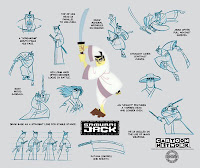- 上層分類: 動畫製作
- 分類: 動畫與 Rigging
- 作者 WayChang
【AM T&T 該怎麼擺 Pose 呢?】【W⁺】
設計旁白:該怎麼擺 Pose 呢?金摳鬧 ... ( from Here )
【前言】
三篇 「When Deciding on Acting Choices What Factors Help you Decide on Poses?」
三篇 「When Deciding on Acting Choices What Factors Help you Decide on Poses?」
【額外補充】Jais Bredsted, Animationmentor, Class 1, Progress Reel ( 作者部落格
( 為什麼要補充這段影片呢? 我想,看到第二篇時就大概能了解囉~ )
【第一篇】
【原文】【Animation Mentor - Tips and Tricks 】【Dana Boadway】
【When Deciding on Acting Choices, What Factors Help You Decide on Poses?】
【譯註:一些名詞若是平常工作都是用英文講,我就保留英文,在括弧加上中文。】
There are lots of things to take into consideration when you are deciding on poses.
當你要決定一個 Pose 的時候,有許多的功課要做。
First and foremost, there is the character’s personality, physical traits, and usually a library of movements for that character that provide information on how they move, such as walk cycles, postures, etc, and a character “bible” that you can access at the studio. Those things should always be studied very carefully when you are working on a show so that you have a strong sense of how the character moves.
在鏡頭裡發生了什麼事?角色正處於什麼樣的情緒狀態中?應該要有什麼樣的動作才能傳達這些情緒呢?前一個鏡頭和後一個鏡頭的表演是什麼?這些問題都必須謹記在心,才能讓你的表演 不跳 Tone 吻合整體的故事軸線(story arc)。
Is the action in the shot more extreme or subtle? If it’s more extreme, the poses I create are more opposite in juxtaposition to each other. The opposing body lines will create a lot more energy and momentum for a high-energy shot. If it’s a quieter shot, the poses will have less opposition.
鏡頭中的動作是較誇張或較內斂的?如果是誇張的表演,我擺出的每個姿勢對比會較大,大幅度的身型變化會製造很多能量和動感(註一)。如果是相對較內斂的鏡頭,每個姿勢之間,對比會較小。
(但是表演的誇張度跟角色在故事上的影響力並不是成正比的,或是說並沒有直接關係,有時內斂的表演,因故事的鋪陳,也有可能在観眾心中製造很大的衝擊。)
The poses need to very clearly communicate who the character is and what they are feeling at that point in time. Remember, once the shot is playing, those poses are only showing for 1/24th of a second (except in the case of holds of course, but you know what I mean)!
The biggest thing to keep in mind is that good poses will create a very individual personality in the character, rather than just creating generic movement.
這些 Pose(動作)都必須非常清楚地形塑( communicate )出這個角色,以及在這個時間點他們所感受到的。記住,一旦鏡頭完成,按下播放鍵,這些 Poses 僅有二十四分之一秒的生命(當然除了一些會 Hold 住的動作之外啦!你應該懂我意思!)(【W⁺】我打岔一下不過不清楚最後這句是要講啥?因為只有 1/24 秒的時間,所以要更用心做...還是...?)
最重要的是,一定要記住~好的 Poses 才能讓角色的個性更加鮮明獨特(賦予了角色生命),絕對不只是讓這個角色在動而已(generic movement)。
註一:可參考【Line of Action - 表演參考線條】
http://animapp.blogspot.com/2011/04/line-of-action.html
【第三篇】
【原文】【Animation Mentor - Tips and Tricks 】【Shawn Kelly】
【When Deciding on Acting Choices What Factors Help you Decide on Poses?】
The most important thing needs to be the communication of the pose. You should choose your poses based on what that pose is saying to the audience. The pose should, in some way, accentuate the emotion or intention of the character, and augment the performance. The body pose should echo the face in most instances (a shy pose with a cocky facial expression just feels weird and confusing), so that's a good indicator as well.
Pose 最重要的功能就是溝通(傳遞訊息給觀眾),在選擇時必須考慮到~究竟要透過這個 Pose 跟觀眾傳達什麼? Pose 的設計,應該要能幫助到~角色情緒、意圖的表達,甚至是整體的表演。多數情況下,身體的 Pose 要能呼應臉上的表情(一個害羞的肢體姿態配上一張驕傲的臉應該會很怪吧!)這是一個滿好的指標參考,能以此來檢驗自己的 Pose 設計是否妥當。
不過,世上沒有一成不變的道理,規則是死的,動畫師是活的。有時候,某些表演內容是刻意要角色試圖隱藏他們的情緒,在這種狀況下,當然就不須死守這條規則。因此,在肢體表演上就會和臉上的表情有所不同,就有可能透過一些微妙的小動作或是眼神來傳達一些試圖隱藏的訊息。
But in general, my recommendation would be to film your video reference over and over and over, until you are no longer thinking about the actual words of the line, and instead are thinking only about the subtext (what the character means instead of what they are saying) and are actually feeling the true emotions of the characters. If you can get yourself to that place in your video reference, you will discover some very communicative body poses that will take your performance to a whole new level!
通常,我還是建議大家多看電影,一遍又一遍地反覆觀察,直到你不再只是於台詞字面上打轉,而是能意識到演員在表演中的「潛台詞」和「內心獨白」(註三),你就能感受到角色真正的感受和真實的情緒。假如你能從參考的電影中觀察到這些細節~就會發現一些隱含著特別意思的 Pose ,而這些領悟將會讓你的表演進入到另一層次。
Good luck, and have fun!!
祝你好運啦!掰!
註三:「潛台詞」和「內心獨白」
http://www.stonetheatre.idv.tw/daybook_detail.asp?article_id=297
再來補充關於「潛台詞」-「Subtext」... 的表演範例
推薦閱讀皮克斯動畫師 Victor Navone 的文章 - Body Language ( 身體語言 )
作者以1967年電影「惡夜追緝令」( In the Heat of the Nigh ) 中的一個橋段為例,特別是 0:20 到 1:03 這一小段。
摘錄:
Finally, there's the wide shot. Steiger walks away, confident in his argument, and then stops and turns to allow us to focus completely on Poitier with him. Poitier pauses, as if he's still waiting for the train, then you see his resolve crumble, as he grudgingly realizes that he must stay. His stilted, boyish walk and the way he picks up the suitcase are so specific and entertaining to watch. Neither character will admit out-loud that they need each other, and their bodies communicate both resistance and acceptance. So juicy! ( 原文章 )
以上這段是最重要的一段,敘述了著西裝的主角的表演,超棒的!即使他一句話也沒說。
【AM T and T 決定動畫師的優劣要素?】【Yao】
【動畫 與 演戲 acting and animation】【J⁺】
【動畫教學影片 - 頭部、眼睛、嘴巴】【W⁺】
【AM T and T 動畫師應該要用鏡頭角度去『偷』嗎?】【Yao】
【AM T and T 關於角色對話的秘訣】【Yao】
【AM T and T 如何讓不討喜的角色討喜?】【Yao】
【CG動畫的19個常見缺陷(原因及解決辦法)】【W⁺】
【12+2 動畫原則】( 歡迎參與共同編輯 )【W⁺】
【迪士尼動畫師的30項建議 - Ollie Johnston】【W⁺】
【5個格數 - 動畫方法 】【翻譯:Chris Deli】
【Disney Principles 迪士尼動畫原則之 Staging】【J⁺】
【Line of Action - 表演參考線條】【W⁺】
首先,在一般動畫工作室裡頭大概都能看到一些關於:角色性格、身體特徵(physical traits)、還有角色的動作設定資料庫(就像表情會有model sheet一樣,動作也會有設定集),這當中會有像是 Walk Cycle(走路循環)或是一些姿勢動態的設定圖等等,當然還有所謂的角色 Bible(聖經 - 關於角色的所有細節資料)。這些東西都必須要在工作時好好研究研究,才能讓你在設計角色動作時有足夠的 Sense 抓到神髓。
And then, of course, there’s the story.
然後呢? 當然,很重要的,就是「故事」。
What’s happening in the shot? What emotional state is the character in, and what actions do they need to achieve during those frames? What happens in the shots before and after the one you’re animating? These questions will have to be kept in mind so that the action you create in your shot fits well in the overall story arc.
And then, of course, there’s the story.
然後呢? 當然,很重要的,就是「故事」。
What’s happening in the shot? What emotional state is the character in, and what actions do they need to achieve during those frames? What happens in the shots before and after the one you’re animating? These questions will have to be kept in mind so that the action you create in your shot fits well in the overall story arc.
在鏡頭裡發生了什麼事?角色正處於什麼樣的情緒狀態中?應該要有什麼樣的動作才能傳達這些情緒呢?前一個鏡頭和後一個鏡頭的表演是什麼?這些問題都必須謹記在心,才能讓你的表演 不跳 Tone 吻合整體的故事軸線(story arc)。
Is the action in the shot more extreme or subtle? If it’s more extreme, the poses I create are more opposite in juxtaposition to each other. The opposing body lines will create a lot more energy and momentum for a high-energy shot. If it’s a quieter shot, the poses will have less opposition.
鏡頭中的動作是較誇張或較內斂的?如果是誇張的表演,我擺出的每個姿勢對比會較大,大幅度的身型變化會製造很多能量和動感(註一)。如果是相對較內斂的鏡頭,每個姿勢之間,對比會較小。
(但是表演的誇張度跟角色在故事上的影響力並不是成正比的,或是說並沒有直接關係,有時內斂的表演,因故事的鋪陳,也有可能在観眾心中製造很大的衝擊。)
The poses need to very clearly communicate who the character is and what they are feeling at that point in time. Remember, once the shot is playing, those poses are only showing for 1/24th of a second (except in the case of holds of course, but you know what I mean)!
The biggest thing to keep in mind is that good poses will create a very individual personality in the character, rather than just creating generic movement.
這些 Pose(動作)都必須非常清楚地形塑( communicate )出這個角色,以及在這個時間點他們所感受到的。記住,一旦鏡頭完成,按下播放鍵,這些 Poses 僅有二十四分之一秒的生命(當然除了一些會 Hold 住的動作之外啦!你應該懂我意思!)(【W⁺】我打岔一下不過不清楚最後這句是要講啥?因為只有 1/24 秒的時間,所以要更用心做...還是...?)
最重要的是,一定要記住~好的 Poses 才能讓角色的個性更加鮮明獨特(賦予了角色生命),絕對不只是讓這個角色在動而已(generic movement)。
註一:可參考【Line of Action - 表演參考線條】
http://animapp.blogspot.com/2011/04/line-of-action.html
( from Here )
【第二篇】
I like to convey the character’s inner thoughts with posing. For instance, the character might be feeling something but not showing it in an obvious way. Maybe the face will say “mad,” but the body pose is a bit frightened, or maybe the reverse. For example, think about a mother who just found her child who had wandered off in a crowded area. Her body language might show relief, but her face might show anger. Choosing the poses carefully will go a long way, helping your character communicate complex inner feelings and depth.
我喜歡運用 Pose 來傳達角色內心的想法。舉例來說,某個角色可能內心感受到了什麼,但或許不會以很外顯的方式呈現。可能臉上寫著「不爽」(mad)兩個字,但肢體姿態卻隱含著「害怕」(frightened)的潛台詞,也或者相反。再舉一個例子,一個媽媽在人潮擁擠的地方尋找她走失的孩子,她的身體狀態可能呈現出她很需要得到幫助的樣子(relief),但臉上卻可能是很生氣的表情。精心挑選適當的 Pose 能幫助你的角色表達出複雜的內心感受和深度。
小草圖 Thumbnails ( from Here )
I learned from Mark Behm, one of my mentors at Animation Mentor, to always write the emotions (or thoughts) out in words near your thumbnails while you are deciding on poses and planning your scene. It is a constant reminder of the goal of your posing. I can't say how many times I got into a pose and started working on a cool idea, then looked over at the word written next to my thumbnails and realized that the pose I had drawn was not communicating the original emotion. I had gotten wrapped up in creating an interesting pose and lost focus of the bigger picture. Having the emotions written out helped me to quickly make the necessary adjustments and correct the poses. Mark Behm advised me to go through this process every time, no matter how redundant it seemed. And then he disappeared in a puff of ninja smoke.
我從 Animation Mentor 的老師 Mark Behm 身上學到一件事:要經常在小草圖(thumbnails)的旁邊以文字註明出角色的情緒(或想法),這會幫助你在決定 pose 和規畫整個 scene(註二)時,不斷地提醒自己每個 pose 所要達成的目標。
不然會像我一樣常發生降的狀況 :在一個 pose 上鑽牛角尖,開始發展一連串自以為很酷的想法,然後回頭看到自己在小草圖旁寫的文字註記,才又意識到~ 靠 ! 我剛畫的那一堆都沒傳達出最一開始所設定的情緒(或想法)。就因為一時的心血來潮, 自以為 設計了一個有趣的 pose ,有時反而會讓整體的表演失焦。
所以,把角色所要傳達的情緒想法寫下來~確實能幫助我更有效率地做出必要的調整,以及正確的 pose 。Mark Behm 老師給了我這樣的建議:無論做這些事情看起來多麼地無關緊要、看似多餘,務必要讓自己確實地在每次工作時都要經歷這樣的過程。
註二:scene ,通常稱做場景,但有時也是講整個鏡頭(的整體設計規畫),有時 planning scenes 也類似 Staging 的概念。可參考:【Disney Principles 迪士尼動畫原則之 Staging】
Planning Animation ( from Here )
【第三篇】
【原文】【Animation Mentor - Tips and Tricks 】【Shawn Kelly】
【When Deciding on Acting Choices What Factors Help you Decide on Poses?】
The most important thing needs to be the communication of the pose. You should choose your poses based on what that pose is saying to the audience. The pose should, in some way, accentuate the emotion or intention of the character, and augment the performance. The body pose should echo the face in most instances (a shy pose with a cocky facial expression just feels weird and confusing), so that's a good indicator as well.
Pose 最重要的功能就是溝通(傳遞訊息給觀眾),在選擇時必須考慮到~究竟要透過這個 Pose 跟觀眾傳達什麼? Pose 的設計,應該要能幫助到~角色情緒、意圖的表達,甚至是整體的表演。多數情況下,身體的 Pose 要能呼應臉上的表情(一個害羞的肢體姿態配上一張驕傲的臉應該會很怪吧!)這是一個滿好的指標參考,能以此來檢驗自己的 Pose 設計是否妥當。
There is no hard and fast rule for this, as sometimes the performance will call for a character hiding their emotions. In these cases, you usually want to betray the emotions in some way, at least to the audience if not to the other characters, through subtle shifts in the pantomime body poses, or through the eye animation, etc.
不過,世上沒有一成不變的道理,規則是死的,動畫師是活的。有時候,某些表演內容是刻意要角色試圖隱藏他們的情緒,在這種狀況下,當然就不須死守這條規則。因此,在肢體表演上就會和臉上的表情有所不同,就有可能透過一些微妙的小動作或是眼神來傳達一些試圖隱藏的訊息。
But in general, my recommendation would be to film your video reference over and over and over, until you are no longer thinking about the actual words of the line, and instead are thinking only about the subtext (what the character means instead of what they are saying) and are actually feeling the true emotions of the characters. If you can get yourself to that place in your video reference, you will discover some very communicative body poses that will take your performance to a whole new level!
通常,我還是建議大家多看電影,一遍又一遍地反覆觀察,直到你不再只是於台詞字面上打轉,而是能意識到演員在表演中的「潛台詞」和「內心獨白」(註三),你就能感受到角色真正的感受和真實的情緒。假如你能從參考的電影中觀察到這些細節~就會發現一些隱含著特別意思的 Pose ,而這些領悟將會讓你的表演進入到另一層次。
Good luck, and have fun!!
祝你好運啦!掰!
註三:「潛台詞」和「內心獨白」
http://www.stonetheatre.idv.tw/daybook_detail.asp?article_id=297
再來補充關於「潛台詞」-「Subtext」... 的表演範例
推薦閱讀皮克斯動畫師 Victor Navone 的文章 - Body Language ( 身體語言 )
作者以1967年電影「惡夜追緝令」( In the Heat of the Nigh ) 中的一個橋段為例,特別是 0:20 到 1:03 這一小段。
摘錄:
Finally, there's the wide shot. Steiger walks away, confident in his argument, and then stops and turns to allow us to focus completely on Poitier with him. Poitier pauses, as if he's still waiting for the train, then you see his resolve crumble, as he grudgingly realizes that he must stay. His stilted, boyish walk and the way he picks up the suitcase are so specific and entertaining to watch. Neither character will admit out-loud that they need each other, and their bodies communicate both resistance and acceptance. So juicy! ( 原文章 )
以上這段是最重要的一段,敘述了著西裝的主角的表演,超棒的!即使他一句話也沒說。
以上,如有翻譯不當之處,敬請糾正!感激不盡!
以及,感謝兩位同事 Joe 和 Yao 在翻譯時的幫忙與建議!相關閱讀:
【動畫 與 演戲 acting and animation】【J⁺】
【動畫教學影片 - 頭部、眼睛、嘴巴】【W⁺】
【AM T and T 動畫師應該要用鏡頭角度去『偷』嗎?】【Yao】
【AM T and T 關於角色對話的秘訣】【Yao】
【AM T and T 如何讓不討喜的角色討喜?】【Yao】
【CG動畫的19個常見缺陷(原因及解決辦法)】【W⁺】
【12+2 動畫原則】( 歡迎參與共同編輯 )【W⁺】
【迪士尼動畫師的30項建議 - Ollie Johnston】【W⁺】
【5個格數 - 動畫方法 】【翻譯:Chris Deli】
【Disney Principles 迪士尼動畫原則之 Staging】【J⁺】
【Line of Action - 表演參考線條】【W⁺】






